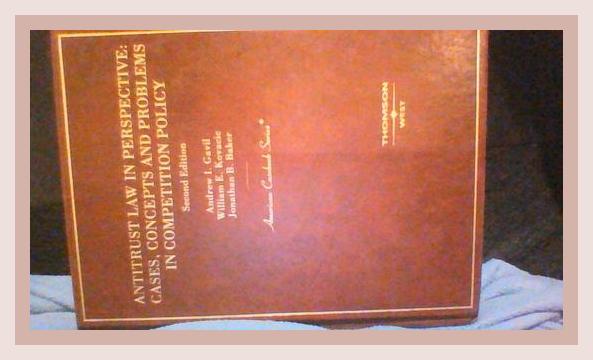Business Law and EthicsAntitrust Laws
Introduction
Antitrust Law in Perspective is a comprehensive exploration of the intricacies of antitrust regulations and their application within the context of U.S. competition policy. Through an array of cases, legal concepts, and practical problems, the authors provide insights into how antitrust laws aim to maintain fair competition and prevent monopolistic behaviors. This summary highlights key points from the book and offers actionable advice based on its content.
1. The Foundations of Antitrust Law
Key Points:
- The origins and philosophical underpinnings of antitrust law are rooted in the desire to maintain competitive markets.
- Early landmark cases like Standard Oil Co. of New Jersey v. United States (1911) played a critical role in shaping modern antitrust policy.
- The Sherman Act, Clayton Act, and Federal Trade Commission Act serve as foundational legal instruments for antitrust enforcement.
Actionable Advice:
- Business Strategy: Ensure your business strategies comply with the Sherman Act by avoiding practices that may be deemed as market monopolization or conspiracies to restrain trade.
- Compliance Training: Provide antitrust compliance training to your staff to mitigate risks of inadvertently violating antitrust laws.
Example:
- The breakup of Standard Oil into 34 separate companies illustrates the enforcement of antitrust laws to dismantle monopolies and promote competition.
2. Cartels and Concerted Actions
Key Points:
- Cartels and concerted actions, such as price-fixing and market division, are per se illegal under antitrust laws.
- The book discusses cases like United States v. Socony-Vacuum Oil Co. that highlight the illegality and severe penalties for such behaviors.
Actionable Advice:
- Internal Controls: Implement stringent internal controls to detect and prevent any form of collusion or improper coordination with competitors.
- Legal Audits: Regularly conduct legal audits to identify and rectify any agreements or practices that could be construed as cartel behavior.
Example:
- The price-fixing conspiracy in Socony-Vacuum Oil resulted in significant fines and reinforced the stance against concerted price manipulation.
3. Monopolization and Market Power
Key Points:
- Monopolization involves the acquisition or maintenance of market power through exclusionary or predatory practices.
- The landmark case United States v. Microsoft Corp. (2001) is examined to illustrate the balance between business success and anti-competitive conduct.
Actionable Advice:
- Market Analysis: Conduct regular market analyses to understand your market share and potential risks related to monopolization.
- Behavioral Policies: Establish corporate policies that discourage exclusionary or predatory practices that could be interpreted as attempts to maintain or acquire monopoly power.
Example:
- Microsoft’s practice of bundling Internet Explorer with its operating system was challenged as a form of maintaining monopoly power in the web browser market.
4. Mergers and Acquisitions
Key Points:
- Mergers and acquisitions can potentially reduce competition and create market dominance, thus antitrust laws closely scrutinize these activities.
- The book discusses cases such as Federal Trade Commission v. Procter & Gamble Co. (1967) to shed light on how mergers are evaluated.
Actionable Advice:
- Merger Planning: When planning a merger or acquisition, conduct a thorough antitrust risk assessment to preempt regulatory concerns.
- Regulatory Strategy: Develop a robust regulatory strategy to effectively address potential antitrust issues with relevant authorities.
Example:
- The FTC’s challenge to Procter & Gamble’s acquisition of Clorox demonstrated the adverse competitive effects of vertical mergers.
5. Vertical Restrictions and Exclusive Dealing
Key Points:
- Vertical restrictions such as exclusive dealing and tying arrangements can sometimes stifle competition and are subject to legal scrutiny.
- The book discusses the case of Eastman Kodak Co. v. Image Technical Services, Inc. (1992), which dealt with tying arrangements.
Actionable Advice:
- Sales Practices: Carefully evaluate your sales and distribution practices to ensure they do not involve illegal tying or exclusive dealing arrangements.
- Legal Consultation: Before entering exclusive agreements, consult with legal experts to assess antitrust risks.
Example:
- Kodak’s restriction on selling replacement parts to independent service organizations was seen as an attempt to monopolize the service market for its products.
6. Price Discrimination and the Robinson-Patman Act
Key Points:
- The Robinson-Patman Act addresses issues of price discrimination that may harm competition by giving some buyers preferential prices.
- Cases such as FTC v. Morton Salt Co. highlight the enforcement of this Act to maintain fair competition.
Actionable Advice:
- Pricing Policies: Develop and implement equitable pricing policies that prevent price discrimination among different buyers.
- Document Review: Regularly review and document your pricing practices to ensure compliance with the Robinson-Patman Act.
Example:
- Morton Salt Co. was found to have engaged in price discrimination by offering more advantageous pricing to larger purchasers, adversely affecting smaller competitors.
7. Enforcement and Remedies
Key Points:
- The enforcement of antitrust laws involves multiple agencies, including the Department of Justice (DOJ) and the Federal Trade Commission (FTC).
- Remedies for antitrust violations can include fines, divestitures, and behavioral remedies to restore competitive conditions.
Actionable Advice:
- Interaction with Regulators: Establish channels of communication with regulatory bodies to address potential concerns proactively.
- Remedial Plans: If faced with an antitrust investigation, develop and propose comprehensive remedial plans to mitigate legal repercussions.
Example:
- In United States v. AT&T, the divestiture of AT&T’s local telephone operations was aimed at dismantling its monopoly and fostering competition in the telecommunications industry.
Conclusion
Antitrust Law in Perspective provides a detailed examination of how competition policy and antitrust laws function to promote fair business practices and prevent anti-competitive behaviors. Through a combination of historical cases, theoretical insights, and practical problems, the authors illustrate the complex landscape of antitrust enforcement. By adhering to the actionable advice derived from the book, businesses can navigate the antitrust terrain more confidently and ethically.
By integrating examples and actionable advice into this summary, readers gain a foundational understanding of antitrust laws’ key aspects, reflecting the book’s intent to educate and guide both legal professionals and business practitioners.
